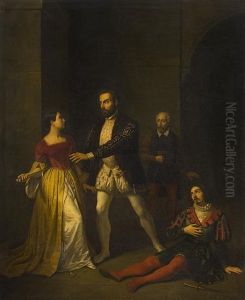Guiseppe Mancinelli Paintings
Guiseppe Mancinelli, not to be confused with the Italian conductor of the same name who lived from 1846 to 1921, was an Italian painter born in Oratino, Molise, in 1829. Mancinelli's artistic endeavors are not widely recognized in the mainstream art history narrative, and as a result, detailed biographical information about him is scarce and not as well-documented as that of his contemporaries. Despite this, some of his works and contributions to the art world during his lifetime have been acknowledged in certain art circles.
Mancinelli was active during the 19th century, a period rich with artistic movements like Romanticism and the later development of Realism and Impressionism. Although his style and the extent of his oeuvre are not thoroughly chronicled, it is likely that his work was influenced by the broader European artistic trends of the time, including the Italian tradition of painting, which placed a strong emphasis on the use of color and the depiction of historical and religious subjects.
The middle of the 19th century was a time of significant political and cultural change in Italy, leading up to the Risorgimento, which resulted in the unification of Italy. These events often provided the backdrop for the art produced during this period, as artists were not only witnesses to but also commentators on the social and political shifts of the era.
Mancinelli's death in 1888 marked the end of a career that likely witnessed the tumultuous unification of Italy and the sweeping changes in the art world. Though specific exhibitions or patronages of Mancinelli's work are not well-documented, his paintings may reside in private collections or regional Italian museums. Due to the limited information available, Guiseppe Mancinelli's legacy in art history remains obscure, and further research would be required to provide a more comprehensive understanding of his life and works.


